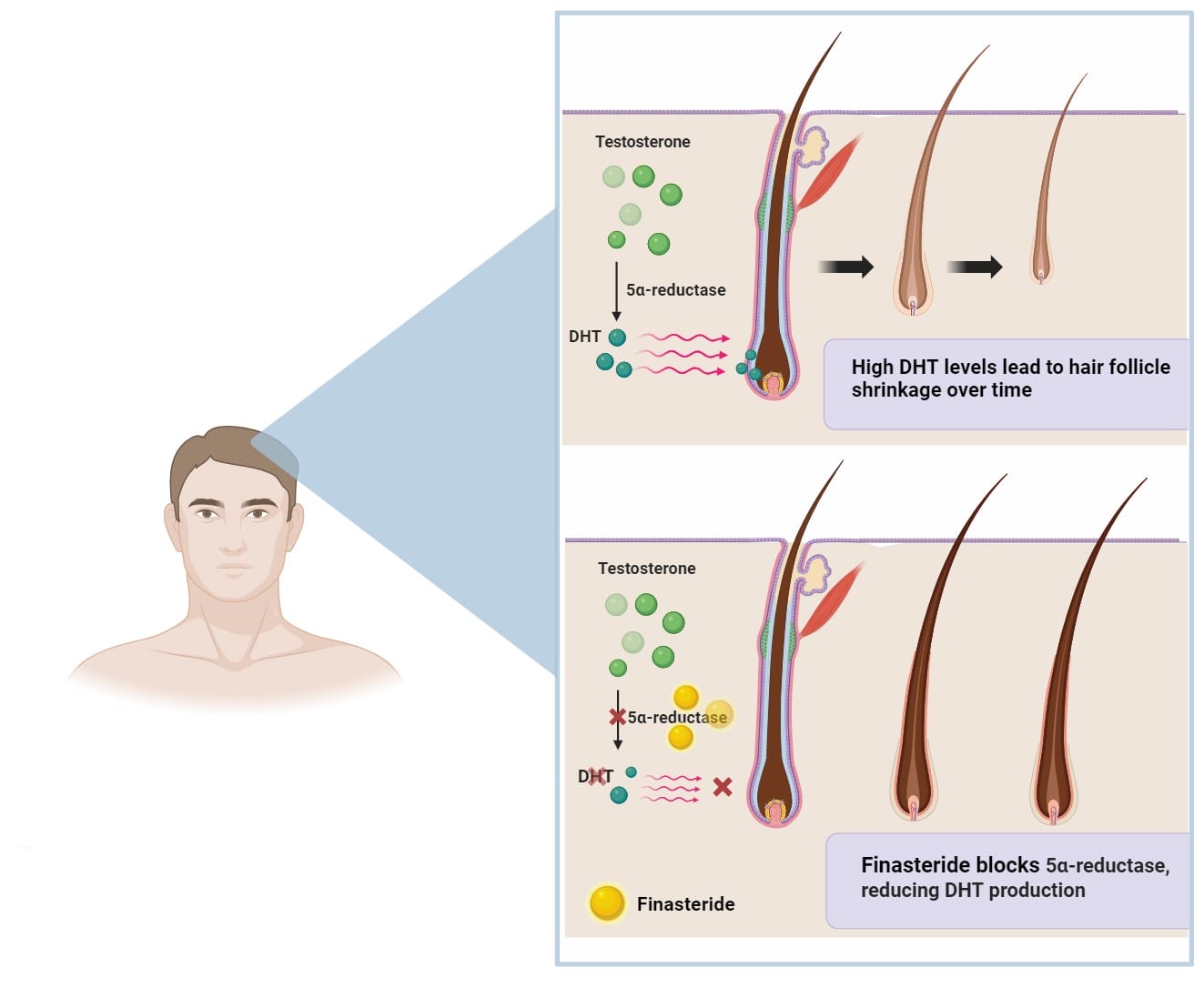Hair loss is a widespread, age-old problem that affects both men and women throughout the courses of their lives. Regardless of identity, hair plays an important role in making us feel confident, attractive and empowered. The journey to fuller hair can be a lengthy one whilst trialing different methods to find an effective solution.
Loss, of any kind, of this valuable asset can lead individuals to seek advice on reviving their tresses through various methods, such as lifestyle changes, medications and surgery.
A commonly used medication used to treat thinning hair is known as Finasteride.
But how long does it take Finasteride to work? And how does it work?
What Is Finasteride?
Finasteride, a popular medication on the market originally used for benign prostatic hyperplasia (BPH), has been a mainstay in the hair loss world since its approval in 1997.
The gold standard medical management for male pattern baldness, or “androgenetic alopecia”, Finasteride is used to slow and effectively reverse hair loss by stimulating regrowth with continuous, regular use.
How Does Finasteride Work?
The adult male human body produces large quantities of testosterone in order to fully mature and develop. One such type of testosterone, Dihydrotestosterone (DHT) has the unfortunate side effect of interfering with the integrity of hair follicles, thus destroying them over time. The continuous destruction of hair follicles causes them to shrink, or “miniaturise” until they eventually stop growing back.
Finasteride helps prevent the production of DHT, and thus stops this damage to follicles, allowing them to grow undisturbed and even return to their original thickness prior to being damaged.

How Long Does Finasteride Take To Work?
The key to a solid result lies in continuous, regular use of Finasteride. Research indicates that results may take up to a year to fully manifest2, so individuals should allow sufficient time for the medication to work on hair follicles before making further decisions based on their hair loss.
The results of a phase III clinical study performed on 1879 men highlighted that 48% of men experienced improvement in hair regrowth at the 1 year mark, and 66% of men experienced improvement at the 2 year mark. Even more remarkably, 83% of men had no further hair loss after 2 years, conveying the effectiveness of the treatment to preserve hair follicles from DHT-related damage.
Whilst on Finasteride, you can start to see results by as soon as 6 months after continuous use, with the first signs of regrowth at the 3-4 month mark following an initial shedding phase. Improvement can continue to be seen for up to 2 years with regular doses, meaning that your hair can continue to improve and thicken up for quite a while if given time.3
What dose of Finasteride shall I take?
The optimal dose of Finasteride for hair loss is 1 milligram (1mg) per day. However, due to the drug’s ability to stay in the bloodstream for longer, Finasteride 1mg can be taken for a minimum of 2-3 times per week in order to still produce results. However, these results may not be robust as a daily dose regime, 7 days a week. Just to reiterate, this medication needs to be regularly and continuously used for at least 3-6 months before evidence of regrowth can be seen. Patience and time is the path to better hair.
The reward for this patience can be further seen in a 2008 study performed over the course of 5 years. In essence, for 1553 men with androgenetic alopecia, taking 1mg per day showed a 93% reduction in the 5-year likelihood of developing further hair loss compared to no treatment.4 This means that in those taking Finasteride to regrow and prevent hair loss, there is a significant decrease in the amount of hair one continues to lose over time. Even if full regrowth is not experienced with long term Finasteride use, it very much helps to halt further progression.
Side Effects and Family Planning
Side effects whilst on Finasteride occur rarely. The most commonly reported side effects include loss of libido and erectile dysfunction. Evidence suggests that healthy, virile men with fertility levels above baseline are not at risk of having their ability to conceive tampered with. Only individuals with lower baseline fertility levels may need to totally consider alternative therapies if they wish to conceive in the near future.5,6
For more information on other medical treatments and therapies you can use besides Finasteride, please feel free to check out our blog here.
What happens if I stop taking Finasteride?
There are a variety of reasons why individuals may not be able to continue taking Finasteride. It is important to know that once Finasteride has been stopped, within a few weeks hair follicles will return to their normal cycles of hair growth and shedding from before starting the medication. If this is of concern, please speak with a qualified healthcare professional regarding the starting and stoppage of Finasteride as well as its regular use.
Conclusion
Losing your hair is a personal and potentially distressing experience, however there is hope to regain back some of what you may have lost. With time, patience and resilience, there are things that can be done to improve the appearance of your hair and help you feel more confident. At The Treatment Rooms London, we strive to guide our patients thoroughly through their hair care journey while providing safe and effective advice. If you would like to get in touch and learn more about how to improve your hair, our professional and friendly team is always at the ready to help.
References
- Finasteride’s impact on hair follicles illustrated using BioRender.com.
- McClellan KJ, Markham A. Finasteride: a review of its use in male pattern hair loss. Drugs. 1999 Jan;57(1):111-26. doi: 10.2165/00003495-199957010-00014. PMID: 9951956.
- McClellan KJ, Markham A. Finasteride: a review of its use in male pattern hair loss. Drugs. 1999 Jan;57(1):111-26. doi: 10.2165/00003495-199957010-00014. PMID: 9951956.
- Whiting DA, Olsen EA, Savin R, Halper L, Rodgers A, Wang L, Hustad C, Palmisano J; Male Pattern Hair Loss Study Group. Efficacy and tolerability of finasteride 1 mg in men aged 41 to 60 years with male pattern hair loss. Eur J Dermatol. 2003 Mar-Apr;13(2):150-60. PMID: 12695131.
- Kaufman KD, Rotonda J, Shah AK, Meehan AG. Long-term treatment with finasteride 1 mg decreases the likelihood of developing further visible hair loss in men with androgenetic alopecia (male pattern hair loss). Eur J Dermatol. 2008 Jul-Aug;18(4):400-6. doi: 10.1684/ejd.2008.0436. Epub 2008 Jun 23. PMID: 18573712.
- Overstreet JW, Fuh VL, Gould J, Howards SS, Lieber MM, Hellstrom W, Shapiro S, Carroll P, Corfman RS, Petrou S, Lewis R, Toth P, Shown T, Roy J, Jarow JP, Bonilla J, Jacobsen CA, Wang DZ, Kaufman KD. Chronic treatment with finasteride daily does not affect spermatogenesis or semen production in young men. J Urol. 1999 Oct;162(4):1295-300. PMID: 10492183.
- Finasteride use in the male infertility population: effects on semen and hormone parameters
Samplaski, Mary K. et al.
Fertility and Sterility, Volume 100, Issue 6, 1542 – 1546
Share:
Authored by
Reviewed by
Book a Consultation
Related Blogs
Ariana Grande Hair Loss: Prevention, Styling Secrets, and Hypothetical Transplant Solutions
April 10, 2025
Ariana Grande, the global pop sensation renowned for her signature high ponytail and bold hairstyles, has openly…
Daniel Craig Hair Transplant: Before, After and His Hairline
April 10, 2025
Daniel Craig, the world-famous English actor who gained international fame as the fast-paced, debonair James Bond, has…
Rob Brydon Hair Transplant: Before, After, and His New Hairline
April 8, 2025
Rob Brydon, the beloved Welsh comedian and Gavin & Stacey star, has traded his receding hairline for…
Gordon Ramsay Hair Transplant: Before, After, and His New Hairline
April 3, 2025
Gordon Ramsay, the fiery Michelin-starred chef, restaurateur, and TV personality, has swapped his receding temples for a…
Has Perez Hilton had a hair transplant? All You Need to Know
April 2, 2025
Perez Hilton is a familiar face in the media. He is known for his work as a…
Ronnie Vint – Love Island Hair Transplant: Before, After, And His Hairline
March 31, 2025
Ronnie Vint, a former footballer and current TV personality, appeared on the 2024 season of “Love Island”…
Prince Harry Hair Loss: Speculations, Treatments, and Possible Transplant Options
March 28, 2025
Prince Harry, the Duke of Sussex and beloved royal-turned-global humanitarian, has sparked global curiosity over his ever-evolving…
Elton John and His Hair Transplant Journey
March 27, 2025
Sir Elton John has had one of the greatest careers in music. Since his rise to fame…
Elon Musk Hair Transplant: Before, After and His New Hairline
March 26, 2025
Elon Musk, the billionaire behind Tesla and SpaceX, is a well known figure for his innovations and…











